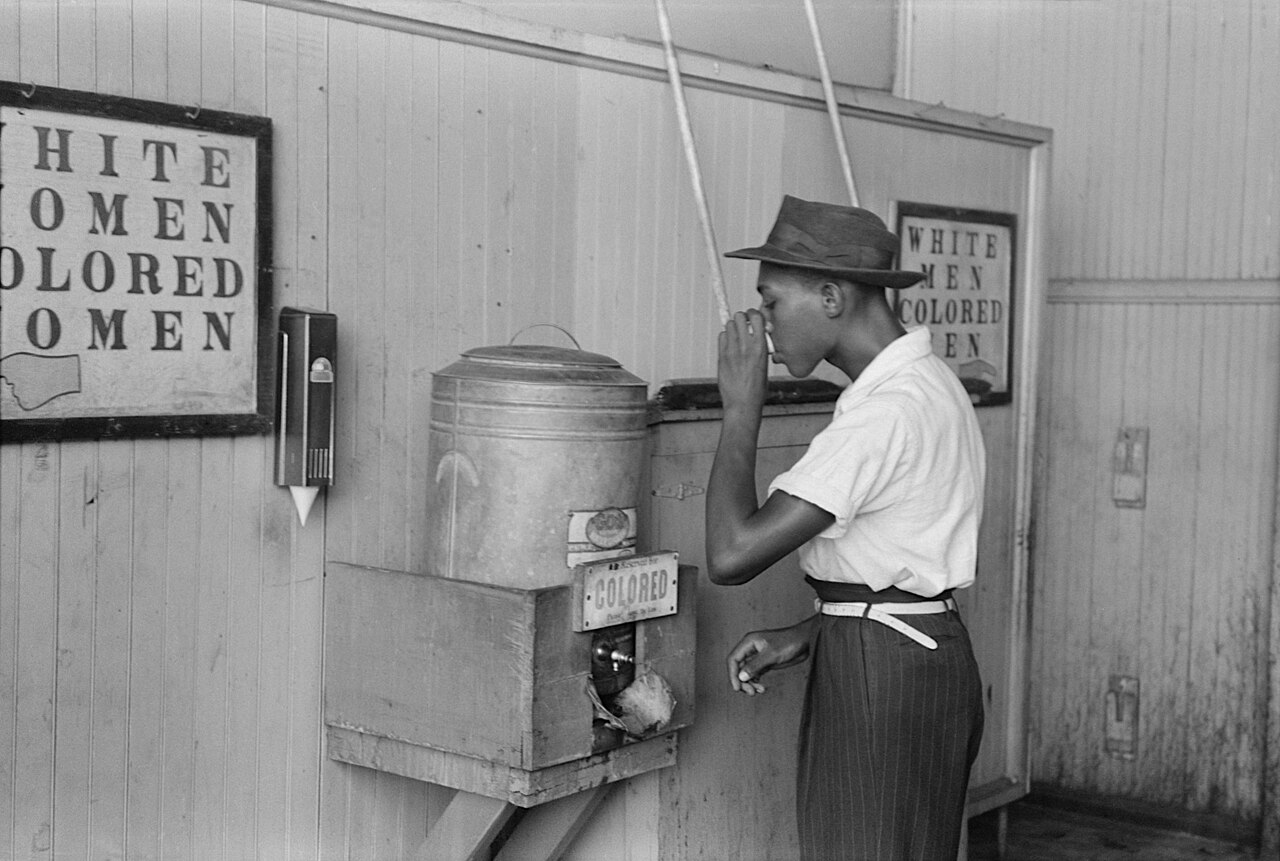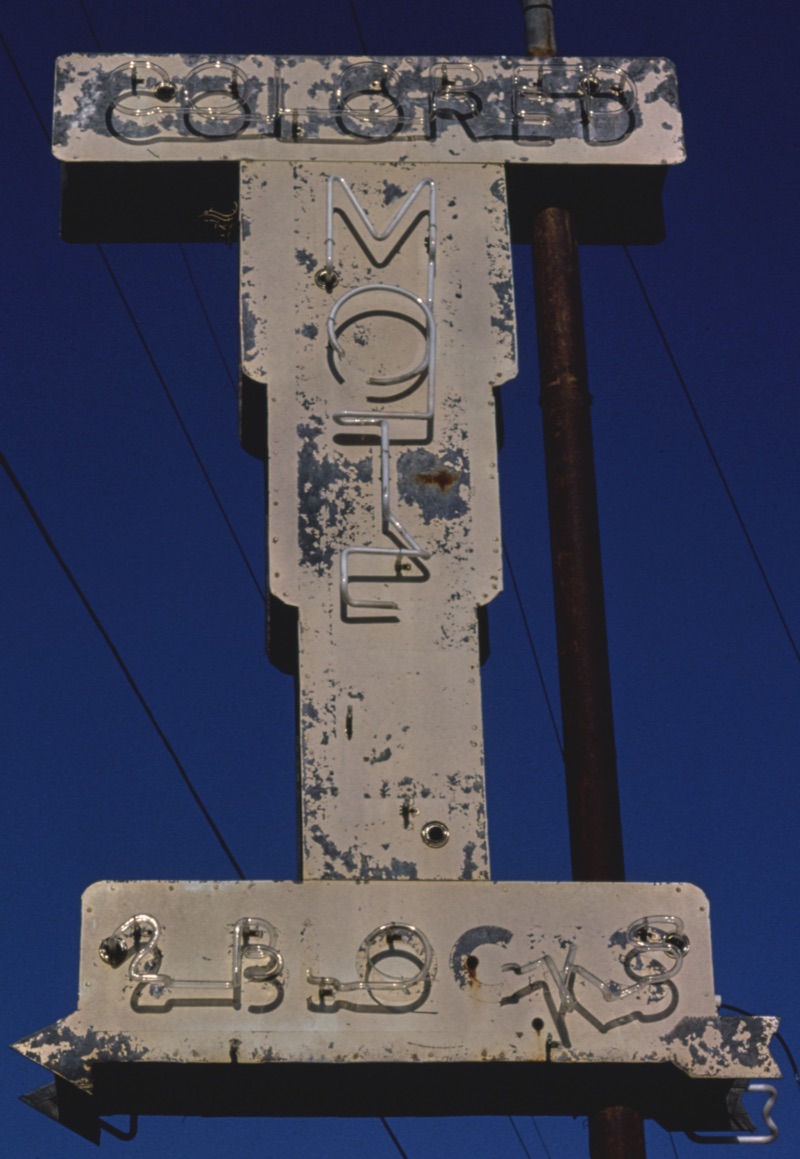
有色・有色人種・有色人
colored, colored people, colored race
Photograph
by Russell Lee showing historical use of the term in the US in contrast
with "white". Besides the big signs, the water cooler itself is
labelled with a sign reading "colored".
☆「有色人種」とは、アメリカ合衆国でジム・クロウ法時代に使われた人種的呼称であり、アフリカ系アメリカ人を指す。多くの地域では差別用語と見なされることがある。[1])
| Colored (or coloured)
is a racial descriptor historically used in the United States during
the Jim Crow era to refer to an African American. In many places, it
may be considered a slur.[1] |
「有色人種」とは、アメリカ合衆国でジム・クロウ法時代に使われた人種的呼称であり、アフリカ系アメリカ人を指す。多くの地域では差別用語と見なされることがある。[1] |
| Dictionary definitions The word colored (Middle English icoloured)[dubious – discuss] was first used in the 14th century but with a meaning other than race or ethnicity.[2][3] The earliest uses of the term to denote a member of dark-skinned groups of peoples occurred in the second part of the 18th century in reference to South America. According to the Oxford English Dictionary, "colored" was first used in this context in 1758 to translate the Spanish term mujeres de color ('colored women') in Antonio de Ulloa's A voyage to South America.[3] The term came in use in the United States during the early 19th century, and it then was adopted by emancipated slaves as a term of racial pride after the end of the American Civil War until it was replaced as a self-designation by Black or African-American during the second part of the 20th century. Due to its use in the Jim Crow era to designate items or places restricted to African Americans, the word colored is now usually considered to be offensive.[3] The term has historically had multiple connotations. In British usage, the term refers to "a person who is wholly or partly of non-white descent," and its use is generally regarded as antiquated or offensive.[4][5] Other terms are preferable, particularly when referring to a single ethnicity. |
辞書の定義 「colored」(中英語 icoloured)という語は14世紀に初めて使われたが、人種や民族性を意味するものではなかった[2][3]。この用語が肌の色が濃い人々の集団を 指す意味で使われた最古の例は、18世紀後半の南米に関する記述に見られる。オックスフォード英語辞典によれば、「colored」がこの文脈で初めて使 われたのは1758年、アントニオ・デ・ウジョアの『南アメリカ航海記』においてスペイン語のmujeres de color(「有色人種の女性たち」)を翻訳するためであった。[3] この用語は19世紀初頭にアメリカ合衆国で使用され始め、南北戦争終結後は解放奴隷たちによって人種的誇りの表現として採用された。しかし20世紀後半に は「ブラック」や「アフリカ系アメリカ人」に取って代わられた。ジム・クロウ法時代にはアフリカ系アメリカ人専用の物品や場所を指すのに用いられたため、 現在「colored」は通常、差別的とみなされている。[3] この用語は歴史的に複数の意味合いを持ってきた。英国での用法では「白人以外の血を完全に、あるいは部分的に引く者」を指し、その使用は一般的に時代遅れか不快とみなされる。[4][5] 特に単一の民族性を指す場合には、他の用語が好ましい。 |
United States Dilapidated hotel sign, Route 80, Statesboro, Georgia. The picture was taken in 1979, after the end of segregation. In the United States, colored was the predominant and preferred term for African Americans in the mid- to late nineteenth century in part because it was accepted by both white and black Americans as more inclusive, covering those of mixed-race ancestry (and, less commonly, Asian Americans and other racial minorities), as well as those who were considered to have "complete Black ancestry".[6] They did not think of themselves as or accept the label African, did not want whites pressuring them to relocate to a colony in Africa, and said they were no more African than white Americans were European. In place of "African" they preferred the term colored, or the more learned and precise Negro.[7] However, the term Negro later fell from favor following the Civil Rights Movement as it was seen as imposed upon the community it described by white people during slavery, and carried connotations of subservience. The term black was preferred during the 1960s by the Black Power movement, as well as radical black nationalists (the Black Muslims and the Black Panthers), pan-Africanists (Stokely Carmichael, leader of the Student Nonviolent Coordinating Committee) and political progressives. "Negro" was still favored as self-descriptive racial term over "black" by a plurality in the late 1960s; however, by the late 1970s and early 1980s, "black" was strongly favored.[6] NPR reported that the "use of the phrase 'colored people' peaked in books published in 1970."[8] However, some individuals have more recently called for a revival of "African American", or "Afro-American", so as to remove attention to skin color.[9] "Colored people lived in three neighborhoods that were clearly demarcated, as if by ropes or turnstiles", wrote Harvard professor Henry Louis Gates, Jr. about growing up in segregated West Virginia in the 1960s. "Welcome to the Colored Zone, a large stretched banner could have said .... Of course, the colored world was not so much a neighborhood as a condition of existence."[10] "For most of my childhood, we couldn't eat in restaurants or sleep in hotels, we couldn't use certain bathrooms or try on clothes in stores", recalls Gates. His mother retaliated by not buying clothes that she was not allowed to try on. He remembered hearing a white man deliberately calling his father by the wrong name: "'He knows my name, boy,' my father said after a long pause. 'He calls all colored people George.'" When Gates's cousin became the first black cheerleader at the local high school, she was not allowed to sit with the team and drink Coke from a glass, but had to stand at the counter drinking from a paper cup.[10] Gates also wrote about his experiences in his 1995 book, Colored People: A Memoir.[11] |
アメリカ合衆国 ジョージア州ステイツボロ、国道80号線沿いの老朽化したホテルの看板。この写真は人種隔離政策終了後の1979年に撮影された。 アメリカでは、19世紀中頃から後半にかけて、アフリカ系アメリカ人を指す言葉として「有色人種」が主流で好まれた。その理由の一つは、白人・黒人双方か ら受け入れられ、混血の祖先を持つ者(より稀にアジア系アメリカ人やその他の人種的少数派も含む)や「完全な黒人の祖先を持つ」と見なされた者まで包括す る表現とされたからだ。[6] 彼らは自らをアフリカ人とは見なさず、その呼称も受け入れなかった。白人からアフリカの植民地への移住を迫られることを望まず、自分たちが白人アメリカ人 がヨーロッパ人である以上にアフリカ人であるとは考えていなかった。彼らは「アフリカ人」という表現の代わりに、「有色人種」あるいはより学識的で正確な 「ニグロ」という表現を好んだ[7]。しかし、公民権運動の後、「ニグロ」という表現は、奴隷制度時代に白人がそのコミュニティに押し付けた表現であり、 従順さを意味すると見なされたため、好まれなくなった。1960年代には、ブラック・パワー運動、過激な黒人ナショナリスト(ブラック・ムスリムやブラッ クパンサー党)、パン・アフリカ主義者(学生非暴力調整委員会(SNCC)のリーダー、ストークリー・カーマイケル)、そして政治的な進歩主義者たちが 「黒人」という用語を好んだ。1960年代後半には、自己表現の人種用語として「ニグロ」よりも「黒人」が依然として多数派に支持されていた。しかし、 1970年代後半から1980年代初頭にかけて、「黒人」が強く支持されるようになった。[6] NPR は、「『有色人民』という表現の使用は、1970 年に出版された書籍でピークに達した」と報じている。[8] しかし、最近では、肌の色への注目を排除するために、「アフリカ系アメリカ人」または「アフロアメリカン」の復活を求める声もある. [9] ハーバード大学のヘンリー・ルイス・ゲイツ・ジュニア教授は、1960年代の分離政策下のウェストバージニア州で育った経験についてこう記している。「有 色人種はロープや回転式改札機で区切られたかのように、明確に境界が引かれた三つの地区に住んでいた。『ようこそ有色人種区域へ』と書かれた大きな横断幕 が掲げられていてもおかしくない……もちろん有色人種の世界は、地区というより存在の条件そのものだった」 [10] 「子供の頃の大半、我々はレストランで食事もできず、ホテルに泊まれない。特定のトイレも使えず、店で服を試着することも許されなかった」とゲイツは回想 する。母親は試着を禁じられた服を買わないことで抵抗した。白人男性が故意に父親の名前を間違えて呼ぶのを耳にした記憶がある。「『あいつは俺の名前を 知っているんだぞ、坊主』と父は長い沈黙の後に言った。『奴は有色人民をみんなジョージって呼ぶんだ』」と。ゲイツのいとこが地元の高校で初の黒人チア リーダーになった時、彼女はチームと一緒に座ってコークをグラスで飲むことを許されず、カウンターに立って紙コップで飲まなければならなかった。[10] ゲイツは1995年の著書『有色人民:回想録』でも自身の体験を記している。[11] |
| Census terms in the United States In 1851, an article in The New York Times referred to the "colored population".[12][full citation needed] In 1863, the War Department established the Bureau of Colored Troops. The first 12 United States Census counts counted "colored" people, who totaled nine million in 1900. The censuses of 1910–1960 counted "negroes". |
アメリカ合衆国における国勢調査の用語 1851年、『ニューヨーク・タイムズ』紙の記事は「有色人種人口」と表現した[12][出典必要]。1863年、陸軍省は有色人種部隊局を設置した。 最初の12回の米国国勢調査では「有色人種」を計上し、1900年にはその総数は900万人に達した。1910年から1960年までの国勢調査では「ニグロ」を計上した。 |
| Term in NAACP The term is still used in the name of the National Association for the Advancement of Colored People, although it is generally referred to as the NAACP.[4] In 2008, its communications director Carla Sims said "the term 'colored' is not derogatory, [the NAACP] chose the word 'colored' because it was the most positive description commonly used [in 1909, when the association was founded]. It's outdated and antiquated but not offensive."[13] However, NAACP today rarely uses its full name and made this decision not long after the United Negro College Fund switched to using just UNCF or United Fund. |
NAACPにおける用語 この用語は現在も全米有色人種地位向上協会の名称に使用されているが、一般的にはNAACPと呼ばれる。[4] 2008年、広報担当カーラ・シムズは「『有色人種』という用語は蔑称ではない。NAACPが『有色人種』を選んだのは、[1909年の協会設立当時]最 も肯定的な表現として一般的に使われていたからだ」と述べた。時代遅れで古めかしいが、侮辱的ではない」と述べた[13]。しかし、NAACPは今日では 正式名称をほとんど使用せず、この決定はユナイテッド・ニグロ・カレッジ・ファンドが単にUNCFまたはユナイテッド・ファンドの使用に切り替えて間もな く行われた。 |
| Anglo-African term Anglo-Indian Anti-racism Black people BAME Casta Colored school Colored American Magazine Critical race theory Free people of color Person of color Negro Nigger Nigga Native American name controversy Race Racism |
アングロ・アフリカン アングロ・インドの 反人種差別 黒人 BAME カースト 有色人種学校 有色人種アメリカ雑誌 批判的人種理論 自由有色人種 有色人種 ニグロ ニガー ニガー ネイティブアメリカンの名称論争 人種 人種主義 |
| References 1. Butterly, Amelia (27 January 2015). "Warning: Why using the term 'coloured' is offensive". BBC Newsbeat. Retrieved 22 February 2020. 2. "Colored | Definition of Colored by Merriam-Webster". Merriam-webster.com. Retrieved 28 April 2016. 3. "coloured | colored, adj. and n." Oxford English Dictionary. 4. "Is the word 'coloured' offensive?". BBC News Magazine. 9 November 2006. Retrieved 18 August 2012. In times when commentators say the term is widely perceived as offensive, a Labour MP lost no time in condemning it "patronising and derogatory" 5. "Definition of coloured in English". OxfordDictionaries.com. Oxford University Press. Archived from the original on 23 July 2012. Retrieved 18 August 2012. In Britain it was the accepted term until the 1960s, when it was superseded (as in the US) by black. The term coloured lost favour among black people during this period and is now widely regarded as offensive except in historical contexts 6. Smith, Tom W. (1992). "Changing Racial Labels: From "Colored" to "Negro" to "Black" to "African American"". The Public Opinion Quarterly. 56 (4): 497, 499–502. doi:10.1086/269339. ISSN 0033-362X. JSTOR 2749204. 7. Trigger, Bruce G. (1978). Northeast. Smithsonian Institution. p. 290. Retrieved 15 January 2017. 8. Malesky, Kee (30 March 2014). "The Journey from 'Colored' to 'Minorities' to 'People of Color'". NPR.org. National Public Radio. Retrieved 5 February 2017. 9. "Afro-American". Merriam-Webster.com. Retrieved 6 February 2019. Definition of Afro-American: African American. First known use of Afro-American 1831, in the meaning defined above 10. Gates, Henry Louis Jr. (Summer 2012). "Growing Up Colored". American Heritage Magazine. Vol. 62, no. 2. 11. Gates, Henry Louis Jr. (1995). Colored People: A Memoir. Vintage. ISBN 067973919X. 12. "[title missing]". The New York Times. 18 September 1851. p. 3. 13. "Lohan calls Obama 'colored', NAACP says no big deal". San Jose Mercury News. 12 November 2008. |
参考文献 1. バターリー、アメリア(2015年1月27日)。「警告:『有色人種』という用語が不快な理由」。BBCニュースビート。2020年2月22日閲覧。 2. 「Colored | Coloredの定義(メリアム・ウェブスター)」。Merriam-webster.com。2016年4月28日閲覧。 3. 「coloured | colored, adj. and n.」オックスフォード英語辞典。 4. 「『coloured』という言葉は不快か?」BBCニュースマガジン。2006年11月9日。2012年8月18日閲覧。評論家がこの用語が広く不快と認識されていると述べる時代に、労働党議員は即座にこれを「見下した侮蔑的な表現」と非難した。 5. 「colouredの英語での定義」。OxfordDictionaries.com。オックスフォード大学出版局。2012年7月23日にオリジナルか らアーカイブ。2012年8月18日閲覧。英国では1960年代までこの用語が通用していたが、その後(米国と同様に)blackに取って代わられた。こ の期間に黒人層の間でcolouredという用語は支持を失い、現在では歴史的文脈を除き広く不快な表現と見なされている。 6. スミス、トム・W. (1992). 「人種的呼称の変化:『有色人種』から『ニグロ』へ、『黒人』へ、『アフリカ系アメリカ人』へ」. 『パブリック・オピニオン・クォータリー』. 56 (4): 497, 499–502. doi:10.1086/269339. ISSN 0033-362X. JSTOR 2749204. 7. Trigger, Bruce G. (1978). Northeast. Smithsonian Institution. p. 290. Retrieved 15 January 2017. 8. マレスキー、キー(2014年3月30日)。「『有色人種』から『少数民族』へ、そして『有色人種』への変遷」。NPR.org。ナショナル・パブリック・ラジオ。2017年2月5日閲覧。 9. 「アフロ・アメリカン」。Merriam-Webster.com。2019年2月6日閲覧。アフロ・アメリカンの定義:アフリカ系アメリカ人。アフロ・アメリカンという用語の最初の使用例は1831年、上記の意味で用いられた。 10. ヘンリー・ルイス・ゲイツ・ジュニア(2012年夏)。「有色人種として育つ」。『アメリカン・ヘリテッジ・マガジン』。第62巻第2号。 11. ヘンリー・ルイス・ゲイツ・ジュニア(1995)。『有色人種:回顧録』。ヴィンテージ。ISBN 067973919X。 12. 「[タイトル欠落]」。ニューヨーク・タイムズ。1851年9月18日。3ページ。 13. 「ローハン、オバマを『有色人種』と呼ぶ。NAACPは大したことではないと表明」。サンノゼ・マーキュリー・ニュース。2008年11月12日。 |
| https://en.wikipedia.org/wiki/Colored |
|
リ ンク
文 献
そ の他の情報
Copyleft,
CC, Mitzub'ixi Quq Chi'j, 1996-2099
Copyleft, CC, Mitzub'ixi Quq Chi'j, 1996-2099
☆
 ☆
☆